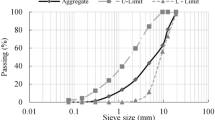Abstract
NT build 443, or profile fitting method, is often used to measure the diffusion coefficient of chloride in concrete. However, this method is quite laborious and needs special equipment. Colorimetric method is a quick and simple method to measure the penetration depth of chloride by spraying 0.1 mol/L silver nitrate solution. The objective of this work is to study the possibility of the use of colorimetric method in the calculation of non-steady-state diffusion coefficient. Twelve concrete mixtures with different supplementary cementitious materials and water-to-cement ratios of 0.35, 0.48 and 0.6 were used for study. According to NT build 443, the concrete specimens were immersed in 165 g/L NaCl (2.8 mol/L) solution for 42 d. Both water-soluble (convert to free chloride) chloride and acid-soluble chloride at different layers of specimens were measured. The results show that the mean value of free chloride concentration at the color change boundary c d was 0.306 mol/L. The surface free chloride concentration c s was obtained by profile fitting method, which was 40% lower than the chloride concentration of exposure solution after an immersion period of 42 d. Chloride diffusion coefficients obtained by the colorimetric method was not well correlated with those obtained by profile fitting method.
Similar content being viewed by others
References
NORDTEST NT BUILD 443, Accelerated chloride penetration [S], Finland, 1995.
YUAN Qiang, SHI Cai-jun, HE Fu-qiang, DE SCHUTTER G, ZHENG Ke-ren. Effect of hydroxyl ions on chloride penetration depth measurement using the colorimetric method [J]. Cement and Concrete Research, 2008, 38: 1177–1180.
TANG L. Chloride transport in concrete-Measurement and prediction [D]. Goteborg, Sweden: Department of Building Materials, Chalmers University of Technology, 1996.
NORDTEST NT BUILD 492, Chloride migration coefficient from non-steady-state Migration Experiments [S]. Finland, 1999.
BAROGHEL-BOUNY V, BELIN P, MAULTZSCH M, HENRY D. AgNO3 spray tests: Advantages, weaknesses, and various applications to quantify chloride ingress into concrete. Part I: Non-steady-state diffusion tests and exposure to natural conditions [J]. Materials and Structure Journal, 2007, 40(8): 759–781.
BAROGHEL-BOUNY V, BELIN P, MAULTZSCH M, HENRY D. AgNO3 spray tests: Advantages, weaknesses, and various applications to quantify chloride ingress into concrete. Part II: Non-steady-state migration tests and chloride diffusion coefficients [J]. Materials and Structure Journal, 2007, 40(8): 783–799.
GLASS G K, WANG Y, BUENFELD N R. An investigation of experimental methods used to determine free and total chloride contents [J]. Cement and Concrete Research, 1996, 26(9): 1443–1449.
OTSUKI N, NAGATAKI S, NAKASHITA K. Evaluation of AgNO3 solution spray method for measurement of chloride penetration into hardened cementitious materials [J]. ACI Materials Journal, 1992, 89(6): 587–592.
HAQUE M N, KAYYALI O A. Free and water-soluble chloride in concrete [J]. Cement and Concrete Research, 1995, 25(3): 531–542.
Tetsuya Ishida, Shigeyoshi Miyahara, Tsuyoshi Maruya. Chloride binding capacity of mortars made with various Portland cements and mineral admixtures [J]. Journal of Advanced Concrete Technology, 2008, 6(2): 287–301.
YUAN Qiang. Fundamental studies on test methods for the transport of chloride ions in cementitious materials [D]. Department of Structural Engineering, Ghent University, Belgium; School of Civil Engineering and Architecture, Central South University, 2009, China.
COLLEPARDI M. Quick method to determine free and bound chlorides in concrete [C]// NILSSON L O, OLLIVIER J P, Eds. Proceedings of the International RILEM Workshop-Chloride Penetration Into Concrete, Paris, 1995: 10–16.
ANDRADE C, CASTELLOTE M, ALONSO C, GONZALEZ C. Relation between colorimetric chloride penetration depth and charge passed in migration tests of the type of standard ASTM C1202-91 [J]. Cement and Concrete Research, 1999, 29(3): 417–421.
MECK E, SIRIVIVATNANON V. Field indicator of chloride penetration depth [J]. Cement and Concrete Research, 1999, 33(8): 1113–1117.
WIENS U, BREIT W, SCHIESSL P. Influence of high silica fume and high fly ash contents on alkalinity of pore solution and protection of steel against corrosion [C]// Proceedings of Fifth International Conference on the Use of Fly Ash, Silica Fume, Slag and Natural Pozzolan in Concrete. SP-153, Milwaukee: American Concrete Institute, 1995, 741–762.
NAGATAKI S, OTSUKI N, WEE T H, NAKASHITA K. Condensation of chloride Ion in hardened cement matrix materials and on embedded steel bars [J]. ACI Materials Journal, 1993, 90(4): 323–332.
Author information
Authors and Affiliations
Corresponding author
Additional information
Foundation item: Project(2010QZZD018) supported by Central South Universtiy, China, and Ghent University, Belgium
Rights and permissions
About this article
Cite this article
Yuan, Q., Deng, Dh., Shi, Cj. et al. Application of silver nitrate colorimetric method to non-steady-state diffusion test. J. Cent. South Univ. 19, 2983–2990 (2012). https://doi.org/10.1007/s11771-012-1367-9
Received:
Accepted:
Published:
Issue Date:
DOI: https://doi.org/10.1007/s11771-012-1367-9




